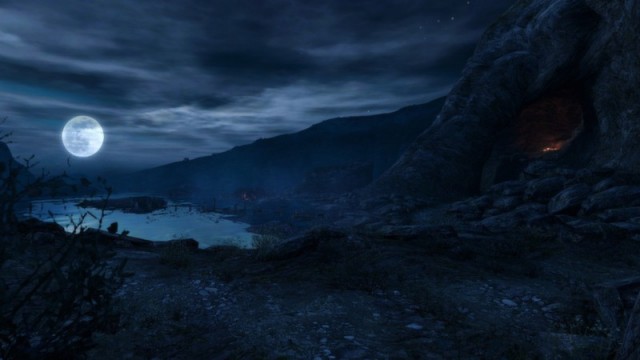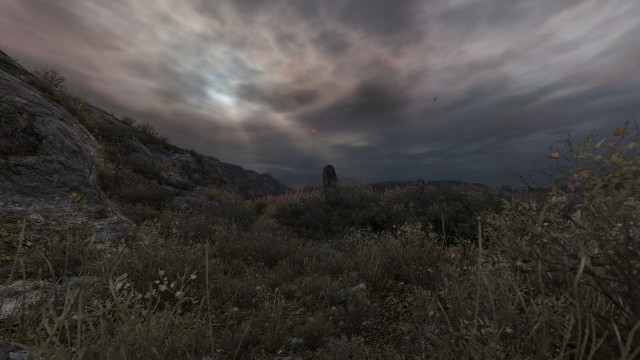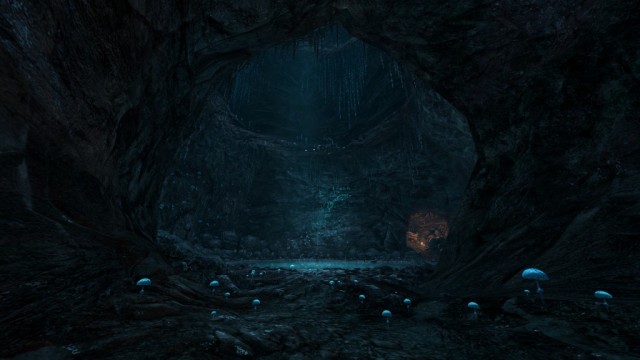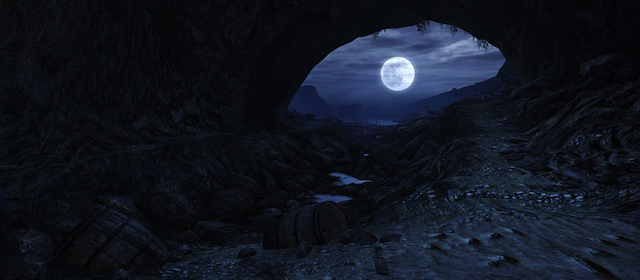If you’re interested in game narrative, chances are you’re excited about the upcoming release of Dear Esther, the “Director’s Cut” of a 2008 mod for Valve’s Source engine. At once a ghost story, an exploration of interactive narrative and an avant-garde interpretation of the FPS, Dear Esther raises as many questions about what games are as it does about how they tell stories.
Giving players the power only to walk forward at a steady pace while taking in their surroundings and listening to an enigmatic voiceover, the game is so startlingly minimalist in its execution that it’s hard to say for certain whether it’s even a game at all. What can’t be questioned however, is its relevance at a time when games of all genres are testing the narrative limits of a medium whose communicative power is often called into question.
As Dear Esther Valentine’s day release draws closer, we talk to its writer and Creative Director Dan Pinchbeck about the game’s design, inspirations, and how research and entertainment are as important to each other as gamplay and story.
Dear Esther makes effective use of a voiceover in order to tell its story. Do you think games need words to tell stories, either through text, dialogue, or as in Dear Esther, narration? If not, what games do you think have told stories successfully without them?
Sure, games can tell great stories without words, and the level of visual and environmental storytelling sophistication we see now is really remarkable. But for me, the great thing about games is the unique capacity to mix all these different storytelling modes together: visual, interactive, player-action-driven, music, voice-over, in-game text. So I think none of those should be ditched – there are cases of great games with great stories that managed without one or more of them, from text-based adventures to the majority of a game like Shadow of the Colossus. But I love the mix – I think getting a really well balanced relationship between all of those is an incredibly powerful and unique way of handling story.

In case anyone reading this doesn’t know, the original version of Dear Esther was a mod in Valve’s Source engine. Was it in any way inspired by Half Life 2, or did Source just provide a convenient platform?
Everything we’ve done is inspired by FPS games is the short answer. I first made Esther when I was doing a doctorate on FPS games, and for me, Esther was a logical extension of the ideas that I was working through which came from them. FPS games have an amazing history and there’s a ton of really incredible ideas about design, storytelling and worlds just there even at the most casual glance, going right back to very early days. So a lot of what ended up in Esther draws from this history.
And I love Half Life 2, it’s just an exemplary game. To be completely honest, the engine was the major draw – we also did a mod in idTech4, but there was a much more limited audience base and it’s a harder thing to work with if you are an untechnical as I am. CryEngine was the other choice, but again, Source had this amazing community to be part of, and the social thing with modding is really important. When Rob and I started collaborating, we talked about maybe shifting engine, but both felt it was important to stay with Source, as this was the community that had really supported Esther and help the game grow. And Source is a great engine to work with. So I guess Esther wasn’t a direct response to HL2, but if you take HL2 as a high-watermark for FPS design, then yeah, it played a bit part in what Esther was.
3. An intrinsic part of Dear Esther’s design is its slow pace and minimal interactivity. Do you think it gets harder to convey an effective narrative the more elements there are to gameplay?
There’s definitely issues of player attention – you can’t expect a player to engage with a complicated, abstract story whilst hurling ballistics at them constantly. That’s one of the reasons openworld games are so powerful – they just create space for both to exist in happily. It depends on the type of narrative you are after, which comes back to the question of which story tools you use. You can do amazing things with visual storytelling without the same need for splitting attention, for example, and a well designed character can communicate a great deal, even in the thick of action – Sully in Uncharted is a masterclass in this.

What I think we found with Esther is that that sense of pace and emptiness buys time and space for an emotional reaction. I really think emotions work at different speeds. You can’t feel sad, fast. And you can’t maintain rage or panic over long periods of time without stimulus. But I think many games are now getting to be very clever at pacing in new ways, to buy that time, and create a much more complex emotional journey. Dear Esther works, and is different, because the downtime is so constant and long. It also creates this tension, where players get quite freaked out and scared because so little happens. That’s really interesting to me on a general design level – that you can hold that tension, that emptiness for so long. You see bits of that in Metro 2033, which is so nearly close to nailing the horrendous, unending tension of Tarkovsky’s Stalker movie, for example. And that’s not about narrative complexity vs gameplay complexity as such, more about grasping the idea that there’s more to a game experience than loops of gameplay. On one hand you have the 30 seconds of fun; Esther shows you can have 90 minutes of sadness. Both work.
Although Dear Esther gives players freedom to wander the island (and the voiceover segments are randomly generated), will they have a better experience if they stick to the more obvious paths?
Well, you can’t deviate that far from the central spine, so the experience will always re-align itself. We’d encourage players to explore as much as they want – there’s a lot of small detail to discover that adds depth to the story.
The original Dear Esther started out as a research project, and thechineseroom’s next venture, Everybody’s Gone to the Rapture, is part-funded by the Arts & Humanities Research Council (UK). How much of your work is driven by the desire to explore narrative, and how much is about creating entertainment?
I don’t see the two as being mutually exclusive, to be honest. What we’re trying to do is explore new areas of design and narrative, but the fact we’re also committed to making games that are rewarding and engaging keeps us honest. There’s no point in researching and having grand theories and ideas if they don’t translate into real-world experiences. So the research has as a basis the idea that although it’s speculative and experimental, it’s not so blue-sky it ends up being something that’s only academically interesting. I think you have to be honest and say that research and experimentation in game design isn’t like high-level physics – it’s not a Hadron collider that only a handful of people worldwide can really understand. Plus, there’s so much innovation in industry, it would be arrogant and just plain wrong to assume that ‘research’ is the exclusive territory of academia.

So the two things are fused for those reasons for me – it keeps the research grounded in the world, and it’s another part of the wider expansion of game design. It just happens to occur within academia. What we’re doing, I hope, as well as making great products, great games, is proving that academia can play a part in that, not just spinning out ornate theories that no-one in industry pays attention to – putting our money where our mouths are. And then we’re also generating ideas that extend beyond our games and have something to say about how narrative can be done in games generally. But I’m also very aware that we are standing on the shoulders of giants here – the games we are making are rooted in the history of FPS design particularly. So it’s not completely speculative – with Esther, we are extending design ideas that have been tried and tested in a number of very successful games, like System Shock, STALKER, Marathon. We just pushed them further, into a new design space.
Although the upcoming release of Dear Esther looks and sounds absolutely beautiful, its concept is quite simple, and something like it could arguably have been made in the 90s. Why do you think it has taken so long for game narrative to receive this attention?
As I said, I think we’re building off ideas that have been around for a long time. System Shock was the first FPS to really do that thing of disassociating the timeline of the story from the timeline of the player’s actions, so you have this fuzzy area where partially you were uncovering events that had happened already, then that collapsed into what is currently going on. That’s an inspiration for doing that here, and it’s become more common in FPS games, although rarely as well – particularly with System Shock 2, which is brilliantly orchestrated. Also in SS2, there are things like the Siddons and Suarez subplot, which is only ever partially told, leaving this fantastic ambiguous space where you really don’t know for sure what’s happening to these characters, but you really care about them. BioShock of course did this exceptionally well too, and it’s much more sophisticated than the standard ‘you are solving the mystery / uncovering the truth’ angle you get a lot of.
More recently (well, more recent than the first Esther), you’ve got games like Metro, where you NEVER find out the reality of a lot of the situations. What I particularly love about what 4A did was they just dumped you into this world and said ‘you’ll never understand most of it’, but the reality they put forwards is so engaging, so immersive, you just don’t care. Games are getting better at avoiding the mistake of feeling like they have to tell the player everything – they are embracing ambiguity in a really positive way. But that’s been there for a long time. So it certainly helps that we have games like these, and Far Cry 2 and the Half Life series, that have driven narrative forwards, just by pushing the agenda that narrative is a hugely powerful design tool when it’s aligned with gameplay properly.
We had this false idea that narrative and gameplay are antagonistic for a long time – and that’s not just in industry, it was rampant in game research for years – and it’s just garbage. It can be tricky to make the two work together, but no harder than coding a decent physics system. But recognising that story IS gameplay is central to moving on from that, and we’re seeing more and more companies really get that and invest care into story. If you get it right, it can transform a game. So I’m not sure, as all the building blocks have been there for a long time. Maybe it’s a market-driven thing – we needed enough highly visible, successful games to appear that shouted out about how important story was to get a critical mass, and the really cool thing about games is that it didn’t come from academic research, it was mainstream titles from big developers that achieved that – Valve, Naughty Dog, Ubisoft, 2K. We don’t celebrate enough that the spread of innovation across games is actually pretty even. That’s quite something.
We’d like to thank Dan for taking the time to give us such thoughtful answers.
The new version of Dear Esther is available on February 14th. To find out more, head to the Dear Esther website, or to thechineseroom.com, home of the game’s developers.





